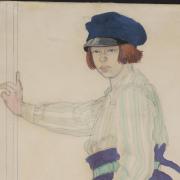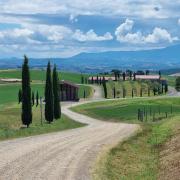I love the Australian outback, the drifting scent of eucalyptus and how the birdsong hangs in the heat. I first went to Australia when I was 16, I was done with public school and public school was done with me. So here was a land, a place full of sky, a great red earth and, in the outback, a lot of rough and ready. I returned there around eight years ago with a camera crew and that longing for all that space resurfaced. After a night in a suburb of Sydney dancing naked with a coven of witches we set off the next morning into the interior, onto dirt roads and into the land of flies.
When at last we stopped it really was in the middle of nowhere and I remember standing there mesmerized by a white trunked gum tree which had yellow leaves and was growing out of red earth. Maybe over here there is a lone Field Maple with yellowing autumn leaves but the red soil is only visible when the land has been recently ploughed.
November in England is the time of full ‘tinting’ - the word that arboriculturists use to describe the changing colour of leaves. Full tinting is when the leaves on one tree change colour completely. A full grown oak in its prime can have up to a million leaves and I would imagine a full grown beech has roughly the same number. That’s a lot of colour when the time comes.
Leaves change colour as the temperature begins to drop in autumn. When this happens the production of chlorophyll, which gives the leaves their green appearance, slows down. As the production of chlorophyll slows it reveals other chemical compounds already present in the leaves. Cold nights destroy the chlorophyll and when this happens the flavanols and carotenoids which are predominantly yellow and orange are revealed. But if the temperature stays above freezing the production of another chemical within the leaves, anthocyanin, increases and the leaves take on a red or purple hew. A similar reaction occurs in a dry autumn when again more anthocyanin is produced.
Every year each tree will react slightly differently depending on the prevailing weather conditions. In some years an October storm will take most of the leaves from the trees before the tinting has really set in. Occasionally there is a calm autumn and then the full vibrancy or reds, oranges and yellows come alive if this happens then November becomes truly vivid and Ashdown Forest, Chailey common, and the Weald and Brede high woods literally light up, - and yes it is worth wrapping up for the last dance. These colours sear into the memory and if you can catch a falling leaf, which is not an easy thing to do, then you are entitled to make a wish.
Perhaps it is because by the end of March we are all hungry for blossom and for the whites and pinks of spring. That we know summer, rather than winter, is to come there is the expectation of light and warmth. But I find the one lone silver birch on a blue November day bright and shrouded with yellow leaves so completely beautiful. There is wisdom in this blossoming.



























